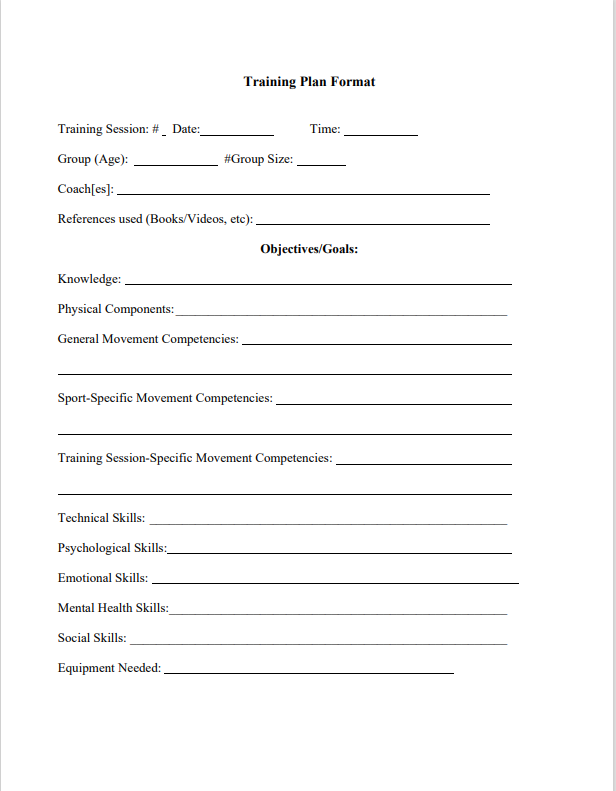Designing An Effective Training Plan
On the Facebook page “Swim Coaches Exchange”, I noticed several examples of daily training plans listing major swim sets and the required performance times. Each plan, however, failed to provide information on the reason, purpose, objective, or goal of such workouts. Thus, if I were to observe the practice session, I would not have a clue about the workout on their Whiteboard at the pool site.
The Daily Training Plan is a framework that entails general and specific information essential for professional transparency and serves as a modus of operation in case of liability. It provides evidence on programming and coaching content and methods, age-appropriate exercises, and sound progressions. All Training Plans make up the seasonal/annual program, are kept in a binder, and are available to persons with concerns about the programming, for example, club administrators or parents. Furthermore, any substitute coach needs to have access to a copy of that plan in case of sickness or absence of the Head coach. Foremost, it serves as a source of accountability and transparency in case of litigation or questions by parents, administrators, etc. I actually, served as an expert witness at a one-million-dollar lawsuit in gymnastics as the judge questioned the coaching progression for the particular skill when the injury (fall on the uneven bars) happened. The training plan did not provide details…
I want to provide information on the importance of an effective training plan that applies to every sports coach. I have spent over 46 years in the Canadian National Coaching Certification Program, and I consider myself an expert on teaching/coaching theory and effective practices/workouts. Plans frequently seem to miss the necessary steps or considerations during the Pre-season planning process (conducted way ahead of the Start-up of the program). Furthermore, plans need to indicate the Pre- and Post-training activities, and the physical, technical, psychological, and mental components that have to be developed or trained.
General Plan Framework:
The Canadian Coaching Association/National Coaching Certification Program (NCCP) re-labelled the ‘traditional’ Warm-up and Cool-down terminology as “Pre-training and Post-training phases” in 2021. What does this mean? Essentially, both Pre- and Post-training need to develop and increase the so-called ‘general movement competencies’, i.e. the physical attributes or components needed to perform the required skills and movement or movement patterns, followed by sport-specific movement competencies, as both link to the actual training session with the training-specific movement competencies to create the so-called “internal movement flow”, which makes training sessions more efficient and functional. The Post-training phase incorporates additional general or supplementary movement or sport-specific movement competencies for further physical and technical enhancement.
Pre-training Phase:
General Movement Competencies
These competencies comprise physical attributes/components (former general athleticism) in line with the Long-term Athlete Development Model (LTAD) and the ABCs components of Physical Literacy (Agility, Balance, Coordination, and Speed). Coaches select the most needed or suitable components depending on the annual or seasonal cycle.
Sport-specific Movement Competencies
These competencies relate to the physical components and skill requirements of each specific sport to be successful in such sport.
Training Session-specific Movement Competencies
These competencies are trained in the Pre-phase as a direct link to each specific training session to produce successful training performance.
Overall, the ‘internal flow’ is designed to improve the learning of general and sport-specific skills, to make it easier to train more efficiently and effectively, and therefore creates more time to spend on technique and refinement of skills.
Post-training Phase:
General Movement Competencies
The phase adds additional or enhances selected physical components in combination with strength and balance, balance and flexibility, PNF exercises, etc.
Sport-specific Movement Competencies
The phase includes additional selected physical components to enhance sport-specific ski skill requirements
Training Session-specific Movement Competencies
This phase presents the “physical and psychological come-down” from the training session
It involves muscles or muscle groups used predominantly in the session
It provides functional exercises for limbering down or warming down as a transition from intense physical activities
Enhancing Activities
It includes activities for mental wellness, such as Progressive Relaxation, Yoga, Pilates, or similar methods
Evaluation
The post-training phase closes with the evaluation of the training session
Athletes
Coach/Coaches
Session Completion and Success
PLAN Segments:
Introduction
Stating and explaining the training objectives and goals for the day
Pre-training Phase (former Warm-up)
It involves the training of general, sport-specific, session-specific movement competencies; dynamic moving and dynamic stationary exercises or activities
Main Theme
It consists of physical and technical skill learning; reviewing skills; refining skills, selected drills and exercises; number of repetitions and sets; volume and intensity
Post-training Phase (former Cool-down)
It involves developing or refining general and sport-specific movement competencies; selecting attributes/components for the enhancement of specific skills; selecting relaxation exercises; practicing mental wellness skills
Evaluation
It is the assessment of the quality of the training session; athletes’ efforts and success, and the effectiveness of the coaching delivery
Below is a preview of the first page from the full training plan format, available to download for free HERE
